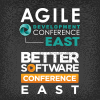Agile Development Conference & Better Software Conference East 2011

PRESENTATIONS
|
Agile Development Conference & Better Software Conference East 2011: Patterns of "Big" Scrum
Nationwide Insurance, one of the largest insurance companies in the United States, is the home of a next generation application development lifecycle fusing a lean software development framework with agile principles and techniques within a CMMI®-compliant methodology. Dustin Potts shares how Nationwide has leveraged the scalability of lean, the flexibility of agile, and the discipline of CMMI® to create a powerful enterprise solution for software development. |

Dan Rawsthorne, CollabNet |
|
Agile Development Conference & Better Software Conference East 2011: Seven Deadly Habits of Ineffective Software Managers
As if releasing a quality software project on time were not difficult enough, ineffective management practices when dealing with planning, people, and process issues can be deadly to a project. Presenting as a series of anti-pattern case studies, Ken Whitaker describes the most common deadly habits-and ways to avoid them. |

Ken Whitaker, Leading Software Maniacs |
|
Agile Development Conference East 2011: A Software Quality Engineering Maturity Model
You are probably familiar with maturity models for software development such as CMMI. In this thought-provoking session, Default.aspx Pope and Ellen Hill describe a corresponding five-stage maturity model for software quality engineering-not just testing-which addresses the challenges organizations face when attempting to improve the their software’s quality. |

Gregory Pope, Lawrence Livermore National Laboratory |
|
Agile Development Conference East 2011: The Agile PMO: From Process Police to Adaptive Governance
Although success stories from individual agile teams on single projects abound, agile adoptions encounter significant challenges scaling to multiple teams on multiple projects. The Project Management Office (PMO), which often remains poorly defined in agile environments, offers the perfect place to oversee and adapt to govern your agile adoption. Sanjiv Augustine shares success stories from industry-leading organizations that are scaling agile to large projects and across many smaller projects. |

Sanjiv Augustine, LitheSpeed, LLC |
|
Agile Development on Large Legacy Architecture
Twenty years of traditional processes produced valuable applications at Integrated Research (IR). However, making changes to software was slow and often introduced quality problems that took months to resolve. When one of their customers offered a great new opportunity, IR had to move with speed they did not possess and achieve a quality level that their old ways would not permit. |
|
|
Agile Pathologies: People Problems in Agile Shops
For agile adoptions that fail, you may not be sure of what went wrong or exactly where but you know something is broken somewhere. And with success, you often do not know what went right. Rajeev Singh shares his experiences regarding emotional and behavioral problems on teams trying to embrace agile values and practices. |
|
|
Agile Requirements Readiness ... and the Role of Testers
Mature agile teams work together to ensure sufficient requirement information is ready when an iteration starts. However, on many teams, developers lack this support and may receive overly detailed-and often ambiguous-requirements that are “thrown over the wall.” Drawing on recent industry research and successes of companies with which he’s worked, Chris Duro shares stories from three companies that evolved an agile adoption requirements readiness assessment framework. |
|
|
Agile Requirements: Not an Oxymoron
Agile processes were originally designed to break down the barriers among users, programmers, and testers. Now, DevOps-an emerging set of principles and practices for communication, collaboration, and integration between development and IT operations-seeks to break down the development/operations barriers. By applying agile principles to operations and re-architecting the interfaces between these groups, DevOps empowers organizations to deliver high-value software faster and with fewer errors. |

Ellen Gottesdiener, EBG Consulting, Inc. |
|
Automation Maturity: Planning Your Next Step in Test Automation
Do you find your organization not achieving the test automation benefits and ROI you expected? Are you spending too much effort rewriting scripts that don't hold up over time? Does your test plan look more like "random acts of automation?" Ayal Cohen describes test automation maturity levels and shares key points on how to determine your test organization's current maturity. Ayal identifies key ideas on how and when to move to the next level. |
|
|
Avoiding Over-design and Under-design
The question of how much-or how little-design to do up-front on a project often leads to a conundrum. Too much design often results in overkill engineering that results in extra complexity and wasted effort. Too little design results in insufficient system structures that result in extra complexity and wasted effort. So, how can you determine the right balance for a given application or system? Alan Shalloway offers a proven approach to determine how much design work to do before beginning the code-build steps in a project. |

Cory Foy, Net Objectives |


